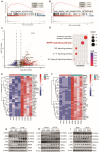METTL3 Deficiency Aggravates Hepatic Ischemia/Reperfusion Injury in Mice by Activating the MAPK Signaling Pathway
- PMID: 38774758
- PMCID: PMC11103385
- DOI: 10.7150/ijms.94177
METTL3 Deficiency Aggravates Hepatic Ischemia/Reperfusion Injury in Mice by Activating the MAPK Signaling Pathway
Abstract
Background: Inflammatory responses, apoptosis, and oxidative stress, are key factors that contribute to hepatic ischemia/reperfusion (I/R) injury, which may lead to the failure of liver surgeries, such as hepatectomy and liver transplantation. The N6-methyladenosine (m6A) modification has been implicated in multiple biological processes, and its specific role and mechanism in hepatic I/R injury require further investigation. Methods: Dot blotting analysis was used to profile m6A levels in liver tissues at different reperfusion time points in hepatic I/R mouse models. Hepatocyte-specific METTL3 knockdown (HKD) mice were used to determine the function of METTL3 during hepatic I/R. RNA sequencing and western blotting were performed to assess the potential signaling pathways involved with the deficiency of METTL3. Finally, AAV8-TBG-METTL3 was injected through the tail vein to further elucidate the role of METTL3 in hepatic I/R injury. Results: The m6A modification levels and the expression of METTL3 were upregulated in mouse livers during hepatic I/R injury. METTL3 deficiency led to an exacerbated inflammatory response and increased cell death during hepatic I/R, whereas overexpression of METTL3 reduced the extent of liver injury. Bioinformatic analysis revealed that the MAPK pathway was significantly enriched in the livers of METTL3-deficient mice. METTL3 protected the liver from I/R injury, possibly by inhibiting the phosphorylation of JNK and ERK, but not P38. Conclusions: METTL3 deficiency aggravates hepatic I/R injury in mice by activating the MAPK signaling pathway. METTL3 may be a potential therapeutic target in hepatic I/R injury.
Keywords: Hepatic ischemia/reperfusion injury; MAPK.; METTL3; apoptosis; inflammatory response; m6A.
© The author(s).
Conflict of interest statement
Competing Interests: The authors have declared that no competing interest exists.
Figures






Similar articles
-
METTL3-mediated m6A Modification Promotes miR-221-3p Expression to Exacerbate Ischemia/Reperfusion-Induced Acute Lung Injury.J Biochem Mol Toxicol. 2025 Apr;39(4):e70235. doi: 10.1002/jbt.70235. J Biochem Mol Toxicol. 2025. PMID: 40127211
-
Mettl3-Mediated N6-Methyladenosine Modification Mitigates Ganglion Cell Loss and Retinal Dysfunction in Retinal Ischemia-Reperfusion Injury by Inhibiting FoxO1-Mediated Autophagy.Invest Ophthalmol Vis Sci. 2025 Feb 3;66(2):58. doi: 10.1167/iovs.66.2.58. Invest Ophthalmol Vis Sci. 2025. PMID: 39982709 Free PMC article.
-
METTL3 Modulates TXNIP Expression to Affect the Activation of NLRP3 Inflammasome in Hepatic Cells Under Oxygen-Glucose Deprivation/Reperfusion Injury.Inflammation. 2024 Jun;47(3):1028-1040. doi: 10.1007/s10753-023-01958-4. Epub 2024 Jan 18. Inflammation. 2024. PMID: 38236385
-
METTL3 inhibits hepatic insulin sensitivity via N6-methyladenosine modification of Fasn mRNA and promoting fatty acid metabolism.Biochem Biophys Res Commun. 2019 Oct 8;518(1):120-126. doi: 10.1016/j.bbrc.2019.08.018. Epub 2019 Aug 10. Biochem Biophys Res Commun. 2019. PMID: 31405565
-
METTL3-mediated m⁶A methylation in cardiac diseases: pathogenic roles and therapeutic potential.Cell Biol Toxicol. 2025 May 20;41(1):87. doi: 10.1007/s10565-025-10039-1. Cell Biol Toxicol. 2025. PMID: 40394351 Free PMC article. Review.
References
-
- Wisse E, Braet F. et al. Structure and function of sinusoidal lining cells in the liver. Toxicol Pathol. 1996;24:100–11. - PubMed
MeSH terms
Substances
LinkOut - more resources
Full Text Sources
Molecular Biology Databases
Research Materials
Miscellaneous

